Image of the Month

Fran Sharp Merrell, August 1977
Merrell, a former UAB student, became the first head coach of the Lady Blazer's basketball team in August 1977. Prior to the establishment of an NCAA-approved athletics program, UAB had offered intramural and intercollegiate teams for its students. The new Lady Blazers basketball team took the court for the first time on November 29, 1978. Merrell coached at UAB until 1981.
Image ID: P23.3

Hillman Hospital Cornerstone, 1963
On July 12, 1902, cornerstones were laid for two new buildings, one for the Hillman Hospital and one for the adjacent Birmingham Medical College. The Hillman Hospital was originally founded as a charity hospital in 1888 by a group of Birmingham women. In 1897 the hospital's governing entity was incorporated by the State of Alabama; the names of these incorporators, the "Board of Lady Managers," appeared on the cornerstone of the new building. Hillman Hospital was opened in July 1903; it remains today on the UAB campus and is known as the "Old Hillman Building."
Image ID: P16.1.1, #0293

UAB’s new process camera, 1977
Paula Dennis demonstrates the largest camera on the UAB campus, the Print Plant’s new room-sized process camera. The camera used 32 x 32 inch film and a 40 x 50 inch copy board. The Print Plant was moved into a leased building on the 2100 block of 5th Avenue South in 1976 and the university acquired several new pieces of equipment to meet the production needs of the UAB community.
Image ID: P7.4.1, #0165

Lister Hill Library, circa 1997
The expanded and renovated Lister Hill Library of the Health Sciences was rededicated in formal ceremonies on May 2, 1997. The original three-story building was opened in 1971 and had been named in honor of Lister Hill, Alabama's long-time member of Congress.
Image ID: P7.3.13

President Charles A. McCallum, Jr., in his office, circa 1987
Dr. McCallum became the third President of UAB in April 1987, and he served until September 1993. He had previously served as Vice President for Health Affairs, as dean of the School of Dentistry, and as chair of the Department of Oral Surgery. Dr. McCallum came to Birmingham in 1951 as an oral surgery intern and, in 1957, received an MD degree from the Birmingham medical school. After he retired from UAB, McCallum served two terms as Mayor of Vestavia Hills.
Image ID: P7.2.1, #1082
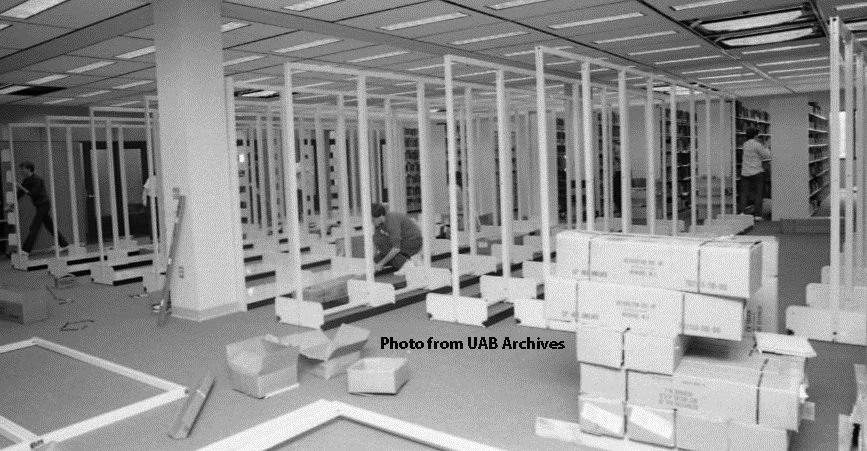
Sterne Library Renovation, March 1987
Before a major move of printed material could be accomplished, new shelving had to be installed by library staff, students, and volunteers. Over 200,000 library volumes were then moved onto the shelving in the new addition of the Mervyn H. Sterne Library so that the original portion of the building could be renovated.
Image ID: P23.3

Medical transcription, 1982
Cecelia Williams, transcription supervisor, uses one of six new word processing terminals installed in the medical records office at University Hospital. UAB was the first hospital in the state to use word processors for transcription. Departmental staff used the new terminals to complete transcription services for UAB physicians.
Image ID: P7.4.1, #2229

Bartow Arena, 1997
On January 25, 1997, the arena was formally rededicated as the Gene Bartow Arena, renamed in honor of UAB’s founding Athletic Director and first coach of the men’s basketball team. Coach Bartow made the first shot in the building when the UAB Arena had originally been dedicated on May 19, 1988.
Image ID: #P23.3

Patricia Livingston on the air at WBHM, December 5, 1976
UAB was granted a license for a public radio station early in 1976, and the station went live on Sunday the fifth of December. WBHM originally broadcast seven-days a week between 6:00 a.m. and 1:00 a.m. and was housed in the old mathematics building at 11th Street South; it remains in the same location today. UAB and the Birmingham community are currently celebrating the 40th anniversary of listener-supported WBHM 90.3 FM Radio.
Image ID: P46.1
On this anniversary of the station, the UAB Archives is pleased to announce the opening of a WBHM archival collection that contains photographs, scrapbooks, publications, etc. Click here to contact the UAB Archives for information on Record Group 46, WBHM 90.3 FM Radio.

Holiday cheer in the hospital, November 1982
Roland Sams, an elevator operator in University Hospital, shared some cheer with patients and visitors during the Thanksgiving holiday.
Image ID: P7.4.1, #2262

Dean Eli Capilouto in front of the Ryals Building, circa 1996
The Frank and Kathleen Ellis Ryals Building, a new home for the School of Public Health, was dedicated October 29, 1996. The Ryals was the first building constructed solely for use by the school. Previously other facilities around campus had been used by Public Health as space became available. Dr. Eli Capilouto was dean of the school from 1994 until 2001. He was Provost of UAB from 2002 until 2011.
Image ID: P6, #0003

Students in Birmingham, circa 1966
On September 15, 1966, the extension program in Birmingham was officially renamed as the College of General Studies. There were 4,600 students enrolled in courses in business, education, engineering, humanities, natural sciences, and social sciences. Dr. George W. Campbell was named as first dean of the new college.
Image ID: P7.3.3, #0088

North Wing, August 1966
The first major addition to University Hospital in decades, the North Wing was dedicated during ceremonies held August 20-21, 1966. The seven story addition provided space for the emergency department, new operating suites, diagnostic radiology, and 100 beds for psychiatric patients. This western side of North Wing is no longer visible as the Quarterback Tower currently stands where the parking lot existed at the time of the dedication.
Image ID: P16.1.3, #3208

Touring University Hospital, 1966
Dr. Alan R. Dimick (left) and Dr. John W. Kirklin (right) provide a hospital tour for a member of the Shriner organization. Kirklin, a renowned surgeon at the Mayo Clinic, was recruited to Birmingham in July of 1966. At UAB he served as chair of the surgery department, as director of the cardiothoracic surgery division, as hospital chief-of-staff, and as founder and president of the Health Services Foundation. He retired from UAB in 1997.
Image ID: P7.2.8, #0359

Honorary Degree Awarded, June 2, 1996
Dr. Joan F. Lorden, dean of the Graduate School, hoods Stevie Wonder during UAB's commencement ceremony. UAB awarded the honorary Doctor of Music degree to Stevie Wonder, the world-renowned singer, composer, and musician. Wonder worked extensively over the years with long-time UAB faculty member Dr. Henry S. Panion, III, who served as chair of the UAB music department from 1994 until 2000.
Image ID: P7.3.13, #0962

Groundbreaking ceremony, May 2, 1991
Dr. John D. Jones, vice president for Student Affairs, watches a member of the UAB community participating in the groundbreaking for a new international house. The Bertha and Joseph Smolian International House on 10th Avenue South was formally dedicated on April 28, 1992. It was named in honor of long-time UAB benefactors; an earlier International House on 9th Avenue South had also been named in honor of the Smolians.
Image ID #P23.3

The dedication of the new SHRP building, April 24, 2002
Dean Harold P. Jones speaks to those assembled, including UAB President W. Ann Reynolds, for the dedication of the first campus facility — visible in the background — constructed solely for the School of Health Related Professions (SHRP). In April of 2006 the school was renamed as the School of Health Professions (SHP), and in 2013 a two-story addition was completed on the school's building.
Image ID: P23.2

Blazer basketball seniors, 1982
With the championship trophy, seniors who helped the UAB Blazers win the Sun Belt Conference Tournament in 1982 are left to right (front row) Raymond Gause and Scott Simcik and (back row) Lex Drum and Cliff Pruitt. UAB first hosted a conference basketball tournament in Birmingham in February 1982. UAB defeated Virginia Commonwealth to win the tournament and gain UAB’s first basketball championship. The 1982 tournament was the most successful in the history of the conference with a record 29,079 attendees. As conference champions, the Blazers automatically advanced to the NCAA tournament where they defeated Indiana — the defending national champions — and Virginia before falling to Louisville. The team’s final record for the season was 25-6.
Image ID: Media Guide
For the second consecutive year, UAB hosted the C-USA Men’s and Women’s basketball tournaments with games played in Bartow Arena and at the Birmingham-Jefferson Civic Center (BJCC). The tournament was held March 8-12. Go Blazers!!!

Aaron L. Lamar, Jr., (center) welcomes two new UAB Ambassadors, 1978
Dr. Lamar joined the UAB faculty in 1973 and in 1978 was named as associate vice president and dean of Student Affairs, the first African American named to a senior administrative position at UAB. Dr. Lamar received the 1994 President’s Medal and remained at UAB until his retirement in 1998. UAB established a student scholarship in his name.
Image ID: P7.4.1, #0694

Members of the UAB Police Department, 1978
Outside the department’s headquarters with a fleet of patrol cars are (left to right): patrolmen J. C. Johnson, Doug Gilmer, Les Nicholson, Jim Hicks, and Sgt. Paul Harrington. The police department was organized in 1972 and occupied a building at 910 South 15th Street until 1992 when the department was moved to a newly acquired building on South 14th Street. The old headquarters building was later used by several UAB departments before being demolished for the construction of the Campus Green.
Image ID: P7.4.1, #0605

Nurses with a special visitor to University Hospital, 1967
Primitiva Isar (left) and Leonides Bulawin (right), who were working in the hospital as Exchange Visitor Nurses, enjoy a visit with Santa Claus.
Image ID: P16.1.2, #2368
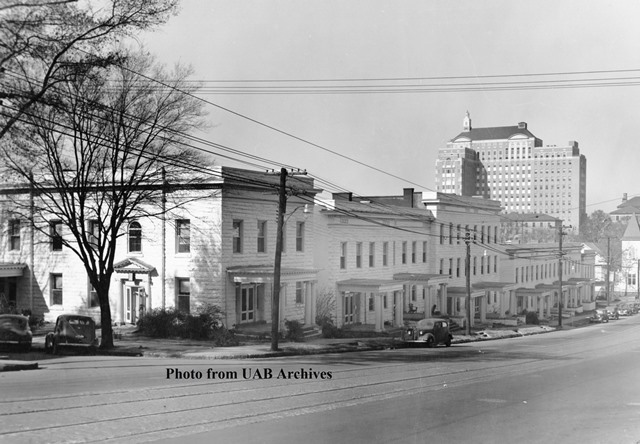
Medical Center Dormitories and Apartments, November 1945
When the medical school was established in Birmingham, the university acquired the former Cullom Apartments for use as faculty and student housing. The 18 apartment buildings fronted South 20th Street and 8th Avenue South. The buildings later held various campus offices, such as the Urban Affairs Institute and offices for anthropology, art, chemistry, biology, and natural sciences. In 1962 some of the buildings were demolished to build the Engineering Building [Cudworth Education Center]. The remaining buildings were demolished in 1969 for the construction of the Kahler Plaza Hotel [Birmingham Hilton Hotel].
Image ID: MC51, #152a

Blaze with UAB Cheerleaders at a basketball game, 1996
The new UAB mascot was unveiled on October 18, 1995, and debuted to the public at a basketball game in Bartow Arena on January 6, 1996. The green dragon named Blaze is the university’s fourth mascot since 1978 when the athletic program was established. Student Wyndall Ivey was the first student to don the dragon costume.
Image ID: P23.1

ROTC Color Guard, circa 1989
The Army ROTC program at UAB was established in September 1980 with 12 student cadets. In 1983 UAB was granted host institution status and became home to the newest battalion of the Army Reserve Officer Training Corps. UAB’s Army ROTC program is currently headquartered in the 501 Building on 12th Street South.
Image ID: P7.2.6, #0021

UAB students, circa 1977
These students make good use of the new pedestrian bridge crossing University Boulevard at South 13th Street. The bridge was completed in 1975 as UAB experienced dramatic growth in the student population. Total enrollment grew from 5,381 in 1969-70 — UAB's first year as an independent university — to 12,119 in 1975-76 the year the footbridge was completed on the western end of the UAB campus. The undergraduate enrollment grew 109% during that time period.
Image ID: P7.2.7, #2065
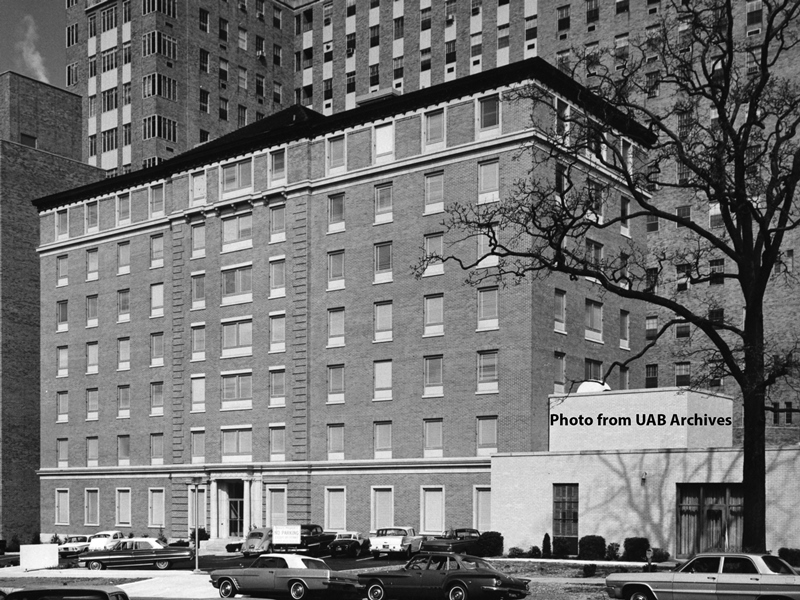
Kracke Building, circa 1965
The Kracke Clinical Services Building on Seventh Avenue South was dedicated on July 18, 1965, and was named in honor of the late Dr. Roy R. Kracke, the first dean of the four-year medical school in Birmingham. The building had opened in 1929 as a dormitory for students of the nursing school at Hillman Hospital and it remained a nursing student residence until 1963.
Image ID: P8.1.1, #0025
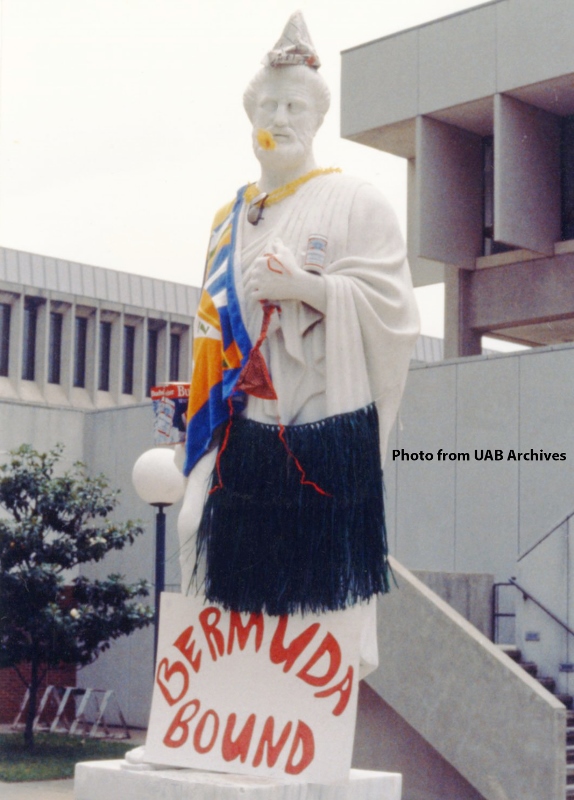
The Statue of Hippocrates, circa 1990
Some UAB students, who were leaving campus for the summer, made known their travel plans by decorating Hippocrates for a beach holiday. The 5,000-pound marble sculpture by Greek artist Kostas Georgakas commemorated the Greek father of western medicine. The piece was presented to UAB in 1971 by Sam and Agatha Nakos, local Birmingham business owners, and originally stood in the courtyard in front of the Lister Hill Library of the Health Sciences. In 1996 the sculpture was moved into the ground-floor lobby of the newly expanded library building.
Image ID: P17.1.10, #0183

Kent State protest at UAB, May 8, 1970
Several hundred students, faculty, and community members held a protest in front of the College of General Studies Building on South 20th Street. The protest was held in support of Kent State University following the deaths of four students who had been killed by the Ohio National Guard on May fourth.
Image ID: P7.3.1, #1026
#may4matters

At work in University Hospital, 1960s
By state law and local regulation, the hospital complex at UAB was segregated by race; a sign noting a white waiting room is visible in this image. This situation began to change in 1963 and effective on April 25, 1965, the hospital and the medical center were integrated. A few weeks later, Federal officials toured the UAB Medical Center and concluded that all policies and procedures of racial segregation had been eliminated and the university was in full compliance with federal law.
Image ID: P16.1.2, #0577
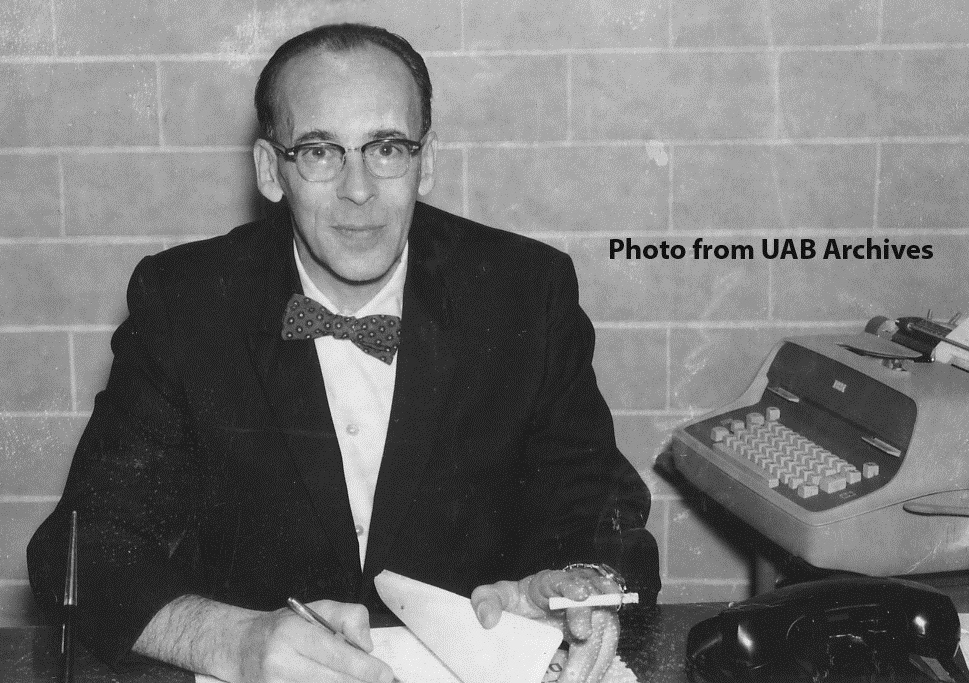
Frederick W. Kraus at his desk, circa 1965
Dr. Kraus was a member of the dental school faculty and was chief of dental service at the Veterans Administration Hospital. One of the founders of the Concerned White Citizens of Alabama, Kraus joined those marching in Selma, Alabama, in March of 1965. He later said he hoped the group's participation would give more Alabamians "the courage to stand up for equality."
Image ID: P7.2.1, #0223

Candles in the Canebrake, February 1955
In 1955 the University’s five-year old Town and Gown Theatre program was moved into a new home, the Clark Memorial Theatre on Highland Avenue. The first production in this new location was Candles in the Canebrake, which opened on February 14, 1955, and told the story of the Vine and Olive Colony settlement near Demopolis, Alabama.
Image ID: P45.2, #0741
On the 60th anniversary of that inaugural performance, the UAB Archives announced the opening of a major collection of Town and Gown archival material, with over 5,000 photographs, hundreds of playbills and event programs, several scrapbooks, and administrative files. Click here to review Record Group 45 or here to contact the UAB Archives for additional information.

Hospital Computer Center, circa 1968
Larry Davis (left) and Floyd Miller (right) operate the IBM computers located in the basement of University Hospital. An automated accounting system for hospital billing and payroll was implemented in 1967.
Image ID: P16.1.2, #2375

UAB art students in the White House, December 1994
First Lady Hillary Rodham Clinton invited college students from around the country to create ornaments depicting the “Twelve Days of Christmas,” the chosen theme for the holiday season. Ornaments submitted by the UAB students were displayed on a 19-foot tree in the Blue Room. The UAB students were given a private tour of the White House as thanks for their contributions.
Image ID: P7.4.1, #1324

Mervyn H. Sterne Library, circa 1975
The library was formally dedicated in May 1973 as part of UAB’s new University College campus. It was officially rededicated on October 23, 1974, as the Sterne Library in memory of a prominent local civic leader, Civil Rights activist, and UAB supporter.
Image ID: P8.1.1, #0049
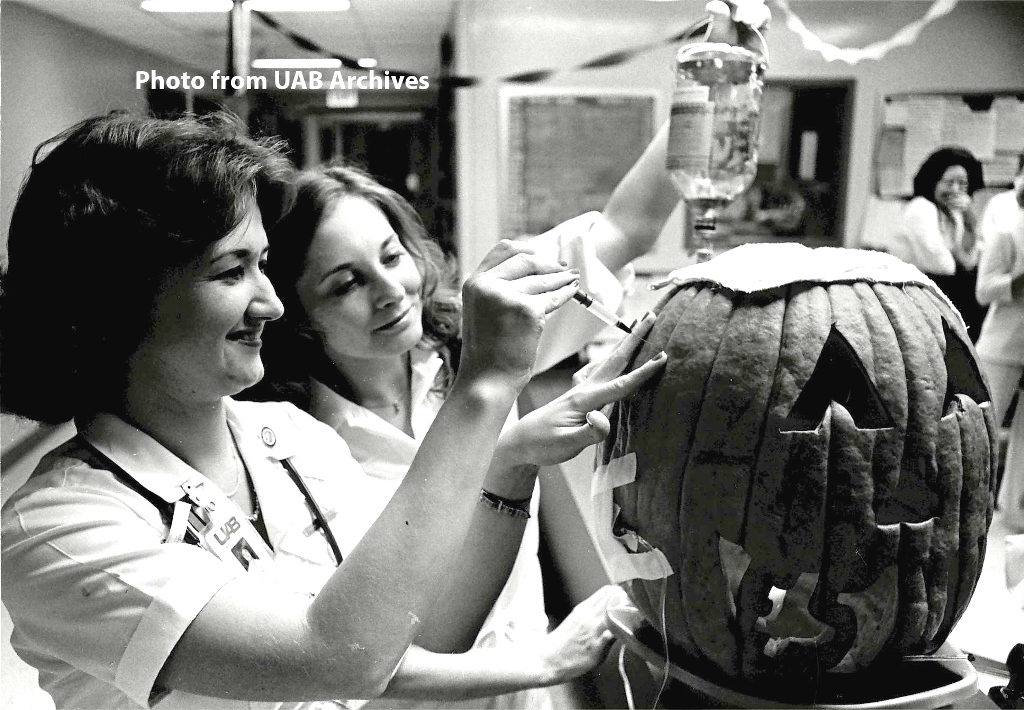
University Hospital's pumpkin carving competition, undated
Image ID: P16.1.3, #3982

John F. Kennedy Exhibit, September 1964
Following the 1963 death of President Kennedy, some of his personal papers and memorabilia toured America. Administrators at the Medical Center were responsible for the display being exhibited in Birmingham on September 16-17 in the gymnasium of the Ft. Mortimer H. Jordan National Guard Armory (later UAB’s Mortimer Jordan Hall).
Image ID: P1, #299e

Dean Roy Kracke at his desk, circa 1945
Dr. Roy Kracke, became the first dean of the new medical school in Birmingham on August 1, 1944. He had one year to set up the four-year school in the crowded Jefferson Hillman Hospital complex, and the first new faculty were hired by the end of the year. Junior students began clinical training in June 1945. Faculty and staff were moved from Tuscaloosa in September and classes for freshmen began on October 8, 1945.
Image ID: MC51, #4843
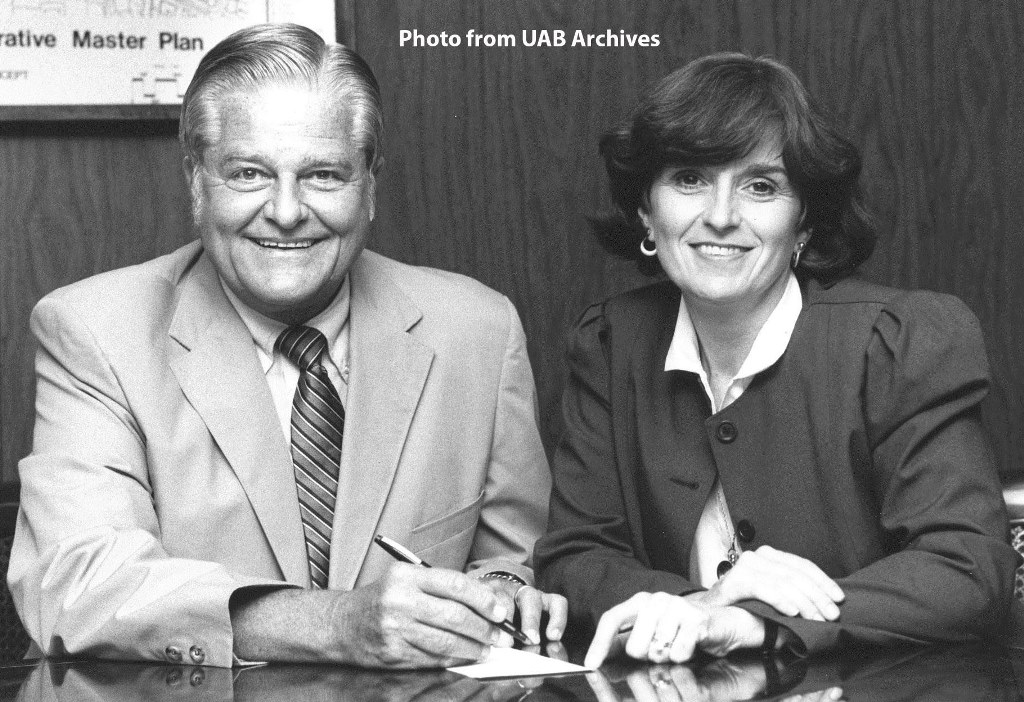
President S. Richardson Hill, Jr., signs the first pledge card for the new UAB Benevolent Fund, 1984
The fund was established in 1984, and in July Dr. Virginia D. Gauld (right) was selected as first president of the UAB Faculty and Staff Benevolent Fund Council, a new 32-member group to oversee UAB’s charitable giving campaign.
Image ID: P7.4.1, #2736

Dr. Virginia D. Horns-Marsh with the UAB Mace, June 1990
Dr. Horns-Marsh, professor of Education, carried the UAB Mace when it was first debuted at the June 4, 1989, commencement ceremony. Created by local sculptor Cordray Parker, the mace was commissioned by Justine and Samuel B. Barker. The Barkers were leading patrons of the local arts community, and Dr. Barker was the first dean of the UAB Graduate School.
Image ID: P7.4.1, #1413
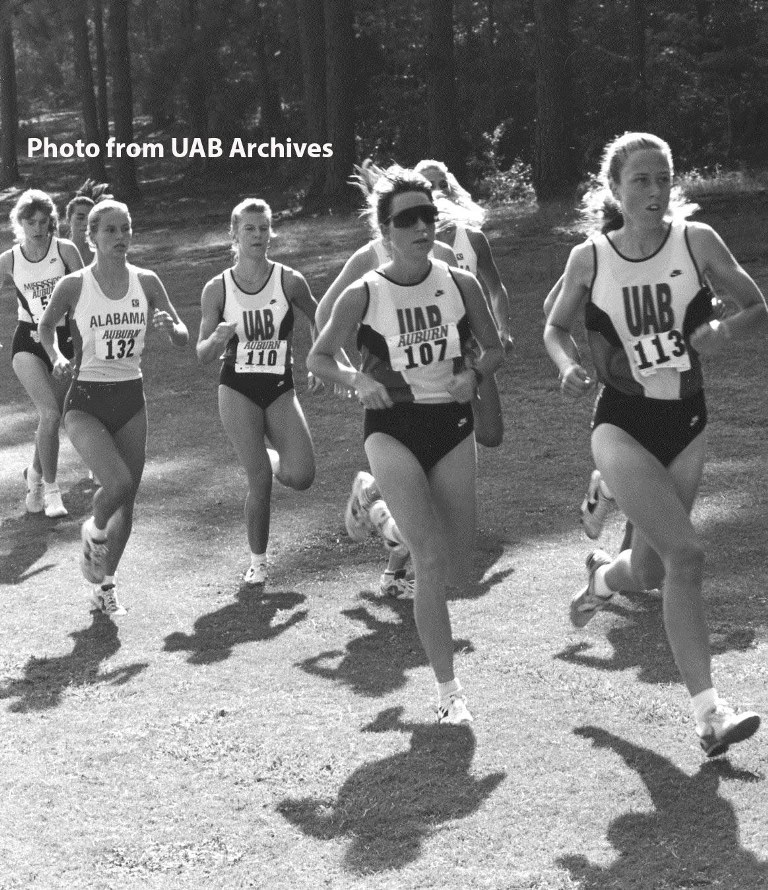
UAB Cross-Country Team, circa 1993
The UAB Blazer Cross-Country Team competed in an invitational tournament held at Auburn, Alabama.
The Women's Cross-Country program was initiated in 1979 with Brenda Williams as the first head coach.
Image ID: P6.1, #3975

Spain Rehabilitation Center opens, April 26, 1964
Hospital Administrator Matthew F. McNulty, Jr. (right), tours Frank E. and Margaret Cameron Spain through the new center named in their honor while hospital staff demonstrate a circular treatment bed. The Spains donated half a million dollars to help fund the Medical Center's rehabilitation facility and the center was officially opened during ceremonies held April 25-26, 1964.
Image ID: P7.2.7, #1549

Distinguished Faculty Lecture, 1964
Dr. Tinsley R. Harrison (right) was the first Distinguished Faculty Lecturer at UAB. His talk, “Witches and Doctors,” was presented on March 3, 1964, at a banquet held at the Parliament House Hotel. The DFL is the highest honor awarded by UAB to a member of the medical center faculty. In 1975 the event was moved from the spring to the fall. Also pictured in 1964 are (left) Dr. Joseph F. Volker, vice president for Health Affairs, and (center) Dr. Frank A. Rose, president of The University of Alabama.
Image ID: P7.2.7, #1894
For all Distinguished Faculty Lecturers, see the chronological history of UAB

UAB buses, circa 1975
A new UAB-wide transportation system, the Blazer Express, was inaugurated in January 2014, but in earlier years the university also provided transportation options. Old school buses, shown here parked near the Ullman-Bell Complex, were used in the 1970s and 1980s to transport students from parking lots to classrooms and to various university events.
Photo ID: P7.4.2, #0015

The Business-Engineering Complex, circa 1985
Opened for classes during the fall of 1983, the Business-Engineering Complex was formally dedicated on January 21, 1984, as a new home for UAB’s Schools of Business and Engineering.
Photo ID: P29.1, #0042
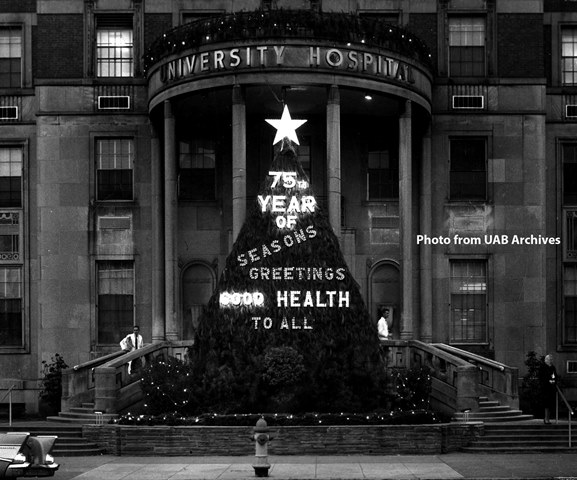
University Hospital celebrates the holiday season, 1963
Decorations installed outside the hospital's main entrance on South 19th Street highlighted the "75th Year of Good Health to All." The predecessor entity of the Hillman Hospital had been established in October of 1888 to provide care for Birmingham's needy citizens.
Image ID: P17, #0090

UAB MedJet in air, circa 1990
The UAB Critical Care Transport Service began in 1983 with transportation by specially equipped ambulance or medical jet. As of 2013 the CCT service has transported over 42,000 patients and has logged more than 27 million miles.
Image ID: P16.1.7, #0028

Business School Backs the Blazers, 1978
A large hallway sign placed in University College Building Number 1 proclaimed “The School of Business Supports ‘Our’ Blazers….and the Entire Blazer Team!” The UAB men’s and women’s teams debuted in basketball games held in 1978. Building Number 1 is the current School of Education Building
Image ID: P7.4.1, #1008

University Hospital Emergency Clinic, circa 1965
On Sunday, September 15, 1963, the emergency clinic at University Hospital received those injured in the bombing of Birmingham's Sixteenth Street Baptist Church. The hospital also received the bodies of the four children killed in the blast.
Image ID: P16.1.1, #0729
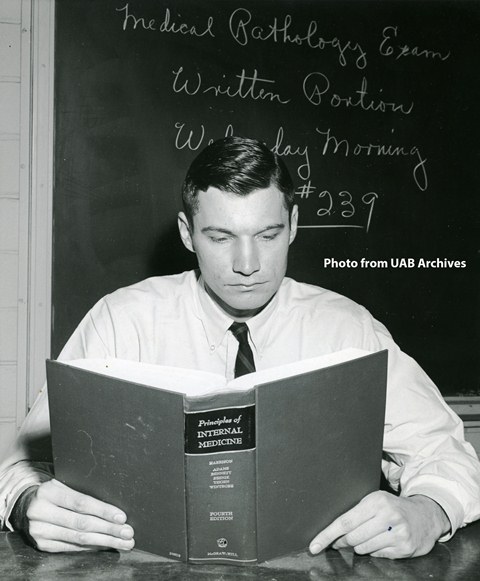
Medical student studies Harrison’s Principles of Internal Medicine, circa 1964
Dr. Tinsley R. Harrison, an Alabama native and long-time member of the UAB faculty, was the author of Principles of Internal Medicine, one of the most widely read textbooks in medical education, a textbook still in use today. Student John A. Harris, shown here, graduated from the medical school in 1966.
Image ID: P7.3.3, #0606

The Medical Center switchboard, circa 1968
Located within University Hospital, the switchboard for the Medical Center was the largest private board exchange in the state and employed a team of 16. The switchboard operators were also responsible for the hospital’s paging and emergency alarm systems.
Image ID: P16.1.2, #2361

Hill University Center, circa 1985
Hill University Center, circa 1985. This building was opened in 1983 and formally dedicated as the University Center in May 1984. In May of 1991 the UC was officially renamed as the Hill University Center in honor of UAB’s second president, Dr. S. Richardson Hill, Jr. The HUC will be demolished this summer and will be replaced with a new building.
Image ID: P7.2.10, #0067

University College dedication ceremony, May 20, 1973
University College Building No. 1, Building No. 2, Building No. 3, and the library – today’s Education, Chemistry, and Humanities Buildings and Sterne Library – were dedicated in a ceremony held in May of 1973. Governor George C. Wallace spoke at the ceremony one year after he survived an attempted assassination at a presidential campaign stop in Maryland. The Governor’s wheelchair is visible as he stands at the podium.
Image ID: P1, #0342

The UAB Police Department, April 1978
Lt. Leo Woods operates the police department's tape machine. The Dictaphone 4000 recorded all telephone and radio calls. A Police Department was formally organized at UAB in 1972.
Image ID: P7.4.1, #0605a

Looking down South 18th Street toward Red Mountain, March 1993
The Blizzard of 1993, the so-called “Storm of the Century,” impacted 26 states and much of eastern Canada, bringing record snowfall across North America. Over the weekend of March 12-13 Birmingham received 13 inches of snow but some locations in the metropolitan area received up to 17 inches. This was a record for a single snowfall and was more than ever received during an entire winter season. All activities at UAB except for essential hospital services were cancelled and many staff remained at their jobs for days.
Image: Progress Notes yearbook

New telephone directory released, 1968
Anita Sellers, secretary in the Office of Communications, with the new and enlarged directory for the university campus. The 6x9 inch publication contained 96 pages with a simple alphabetical listing of staff and an administrative listing of offices and programs. The last printed Campus Directory distributed to the UAB campus was released in 2009. The 8x11 inch publication contained over 570 pages.
Image ID: P16.1.2, #2386

1917 Clinic, circa 1988
In response to the growing epidemic, an outpatient clinic for AIDS patients was opened at UAB in January 1988. It was founded and first directed by Dr. Michael S. Saag. The clinic name originated from the building’s street address of 1917 5th Avenue South in order to protect the confidentiality of the patients.
Image ID: P23.3, #1419
Dr. Michael S. Saag presented the 34th annual Reynolds Historical Lecture, entitled "Thirty Years of AIDS," on February 22, 2013. For additional information see the Special Collections Lectures page.

UAB's annual Toys for Tots drive, 1988.
UAB staff collect items for the annual toy drive.
Image ID: P7.4.1, #0917
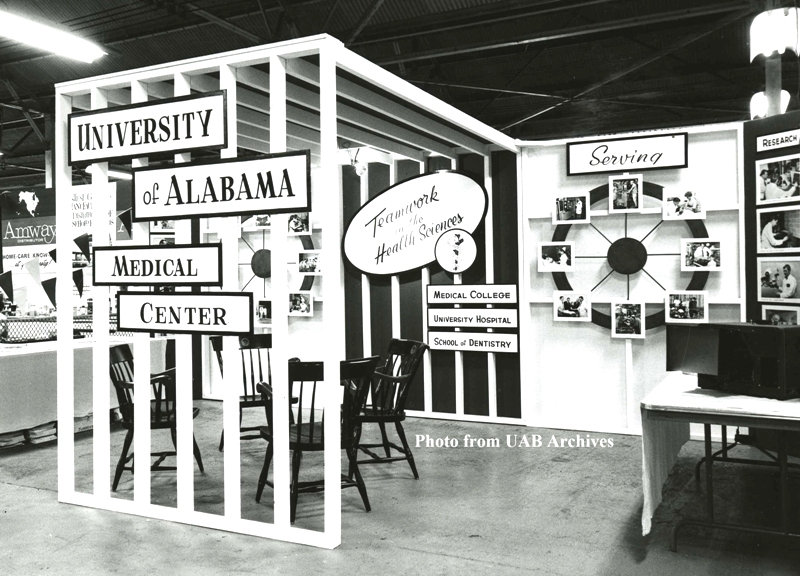
Medical Center booth at the Alabama State Fair, 1965
The booth for the University of Alabama Medical Center at the fair in Birmingham noted “Teamwork in the Health Sciences” and highlighted the medical school, dental school, and hospital.
Image ID: P7.2.7, #0864

Columbus statue unveiled, October 1992
A marble statue of Christopher Columbus was unveiled on the terrace of the UAB Smolian International House as part of Birmingham’s Columbus Day celebration. The project was supported by the local chapter of the Knights of Columbus and by the Bruno family. UAB President Charles A. McCallum, Jr. (far right), Joseph S. Bruno (center), and other guests are shown with the work of sculptor Ugo Sordelli.
Image ID: P7.4.1, #594

The UAB Marching Blazers, circa 1994
Following a debut during an away game, the marching band performed at home for the first time at Legion Field on September 17, 1994, with music professor Clifford Winter (second from right) as band director and student Brian Wilson as the first drum major. UAB had hosted a pep band for basketball games since the late 1970s, but a new NCAA-level football team needed a marching band to perform during half-time shows.
Image ID: P6, #002

The Kirklin Clinic, 1992
In 1990 ground was broken for a new outpatient clinic for The University of Alabama Health Services Foundation. Designed by renowned architect I.M. Pei, the facility was named in honor of Dr. John W. Kirklin, former chair of the UAB Department of Surgery and former president of the foundation. The Kirklin Clinic was dedicated on June 5, 1992.
Image ID: P6, #007

A parade kicks off Birmingham's celebration of the Centennial Olympic Games, July 19, 1996
Legion Field was a host site for soccer matches as part of the XXVI Olympic Games held in Atlanta, Georgia. Over 431,200 people attended the eleven matches held in Birmingham. The West Field on the UAB campus was used as a practice site, and UAB was the location for a reception honoring local volunteers. This parade traveled down South 20th Street through the UAB campus.
Image ID: P23.1

The Shuttle Columbia roars into space, June 25, 1992
Aboard Columbia was Dr. Lawrence “Larry” DeLucas, a member of the UAB faculty and a UAB alumnus. The university’s first astronaut and the first optometrist in space, Dr. DeLucas was a payload specialist aboard NASA space mission STS-50. Columbia and crew returned to earth on July ninth. This image is an official NASA photograph.
Image ID: P7.3.6, #0120
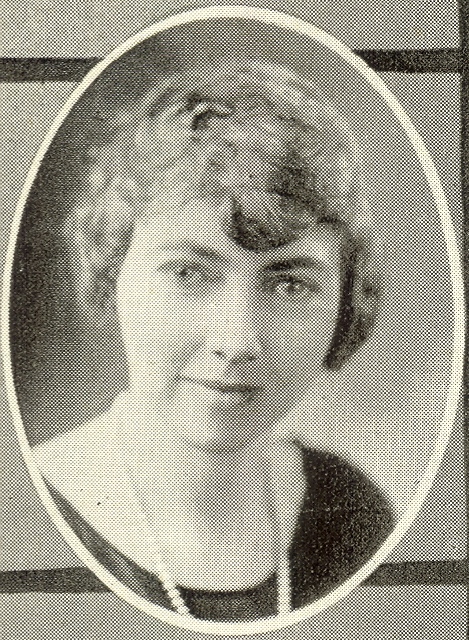
Jimmie Ethel Montgomery, circa 1925
On May 26, 1925, Montgomery received a bachelor's degree in medicine from the two-year basic sciences program at the University of Alabama becoming the first female graduate of the medical school. In 1928 Montgomery received the M.D. from the University of Minnesota. She was a general practitioner in Bibb County, Alabama, and died in 1982.
Image: The Corolla yearbook

Hulsey Fine Arts Center, circa 1982
The Hulsey Center for the Arts and Humanities, more commonly known as the Hulsey Fine Arts Center, was completed in 1981 and was officially opened on April 30, 1982. A renovation project completed in 2004 gave the center a new main entrance along South 13th Street. The Center is named in honor of UAB benefactors William Hansell and Susan Mabry Hulsey.
Image ID: P7.3.3, #70

Officials break ground in the Medical Center for a building to house the Jefferson County Public Health Department, March 12, 1947
Participants include second from left James W. Morgan, County Commissioner; fifth from left James E. Folsom, Sr., Governor of Alabama; sixth from left Dr. D. J. Gill, state health officer, and seventh from left Dr. George A. Denison, county health officer. Dr. Alfred A. Walker, chair of the county health board, operates the steam shovel. When the building opened in 1948, the health department was able to vacate space in the Jefferson-Hillman Hospital that was needed for the growing medical school and the new dental school.
Image ID: MC51, 127i

President S. Richardson Hill, Jr., at his desk, circa 1978
Dr. Hill became the second President of UAB on February 1, 1977, and served until his retirement in 1987. He had previously served as Vice President for Health Affairs, as Dean of the medical school, and as first director of the Division of Endocrinology and Metabolism. Dr. Hill came to UAB in 1954 and he remained involved on the campus until his death in 2003.
Image ID: P7.2.1, #1023

President Charles A. McCallum, Jr., welcomes a visitor to his office in Mortimer Jordan Hall, January 1992
Trash Gordon, the new mascot of the UAB Recycling Program, was introduced that month and appeared at events on campus and around the metropolitan area. The program also introduced a new theme: "We're litter free at UAB: reduce it, redo it, recycle."
Image ID: P7.4.1, #337
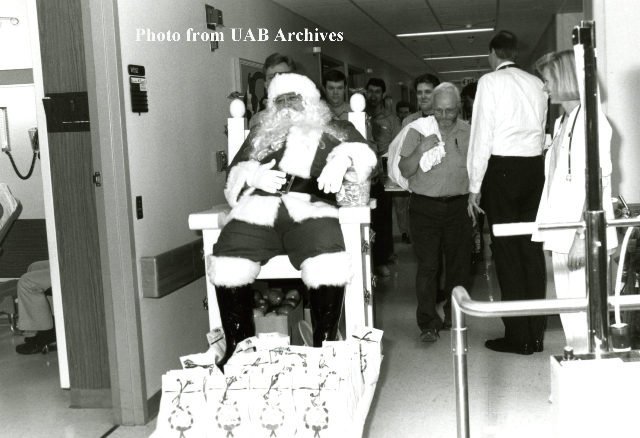
Santa visits University Hospital with a little help from the elves of the Maintenance Department, circa 1990
The University Hospital Maintenance Department began collecting for the Christmas Toy Fund in 1981 to ensure that hospitalized patients received gifts during the holiday.
Image ID: P16.1.11, #0170
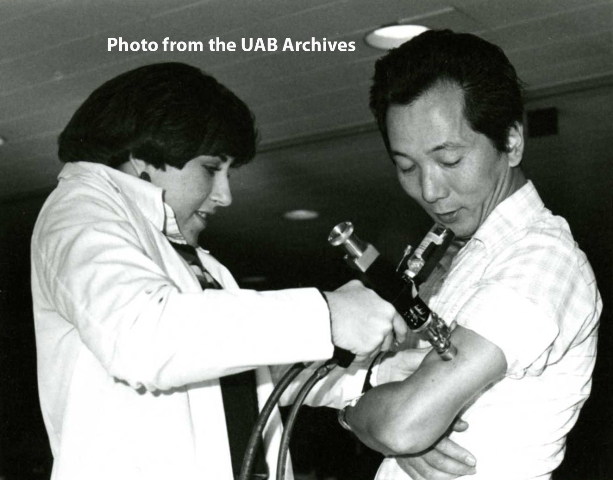
An employee receives a swine flu shot, 1976
University Hospital was the location for UAB staff and employees to receive an inoculation as part of a nation-wide swine flu vaccination effort held during the fall of 1976.
Image ID: P7.4.1, #043
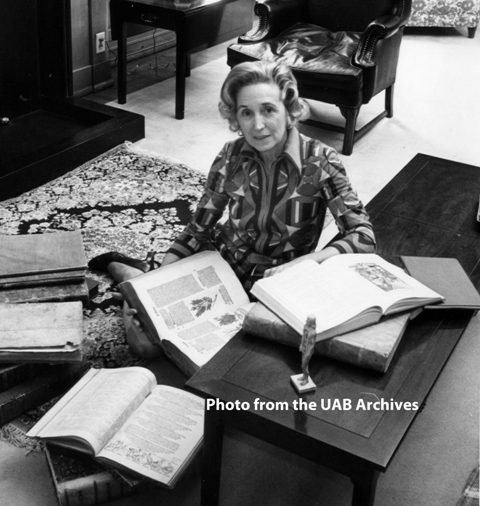
Sarah Cole Brown with rare items from the Reynolds Historical Library, circa 1975
Brown became chief librarian at the Medical Center in 1955 and in October 1971 became the first director of the newly opened Lister Hill Library of the Health Sciences. Brown retired from UAB in 1977.
Image ID: P7.2.1 , #044

Blazer Quarterback Doug Gann (left) in the first NCAA football game for UAB, September 7, 1991
The university fielded a club team in 1989 but in the fall of 1991 UAB began play as an NCAA Division III team. In the game played in Jackson, Mississippi, the Blazers lost to Millsaps College.
Image ID: P6.1, #2742

UAB students staff a table for Alpha Sigma Tau Sorority's recruitment, circa 1971
The Beta Zeta chapter of Alpha Sigma Tau was established in May of 1970 as the university’s first social sorority.
Image ID: P7.3.1, #1025

Whale balloon rises over the UAB campus, 1979
A group supporting a moratorium against whaling brought a 100-foot hot-air balloon to UAB in order to call attention to the plight of the nautical mammals.
Image ID: P7.4.1, #1123
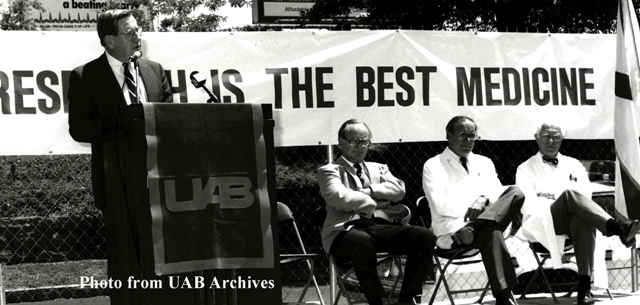
Groundbreaking for a new research facility, June 5, 1990
President Charles A. McCallum, Jr., speaks to the crowd assembled for the ceremony. When opened in 1993 the building was named in honor of Alabama Representative Tom Bevill. Seated on the platform with Dr. McCallum are UAB officials (left to right) Drs. John R. Durant, Vice President for Health Affairs; Victor J. Matukas, Dean of Dentistry; and James A. Pittman, Jr., Dean of Medicine.
Image ID: P6 #01

Dedication of the Bell Building, May 16, 1971
UAB President Joseph F. Volker (left) and members of the Bell family attend the dedication of the Bell Building. Part of the Ullman-Bell complex, the building was named in honor of the late Dr. George C. Bell, who had served as the first principal of the Ullman High School from 1937 until 1965.
Image ID: P1, #0364

Ceremonial first pitch for the Jerry D. Young Memorial Field, April 18, 1985
Brooks Robinson, a Hall of Famer and former Baltimore Oriole, threw out the first pitch at the dedicatory game at the Young Memorial Field. The UAB Blazers defeated Ole Miss 8 to 2. UAB’s first on-campus home for baseball had been in use for just over a year when it was formally dedicated in honor of the founding dean of the School of Business and the Vice President for Finance at the time of his death in 1983.
Image ID: P6.1, #0698

A mummy is scanned in University Hospital, 1988
Prior to being displayed at the Birmingham Museum of Art as part of the Birmingham Festival of Arts, the mummy of an Egyptian female was brought to UAB for examination. Officials used a CAT scan to examine the remains of the 2,000-year old woman, who became the “oldest patient” ever examined at University Hospital.
Image ID: P23.3, #572

Jefferson Hospital postcard, ca. 1941
The county’s new hospital was constructed with over $2 million in federal funding and was dedicated in December of 1940. It was called “the South’s finest private hospital.” The first patient was admitted to Jefferson Hospital on February 1, 1941; he was a construction worker who had helped lay the building’s foundation.
Image ID: MC51, #127g
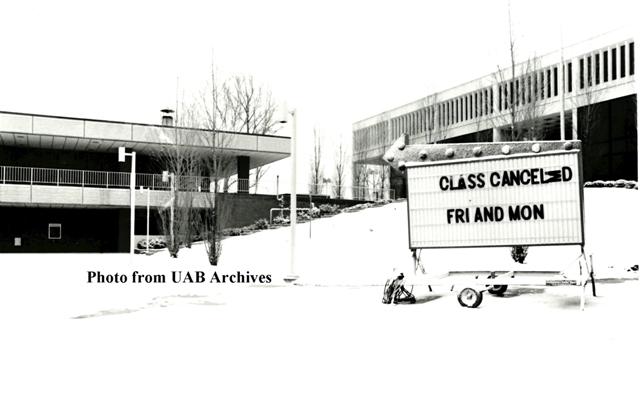
Snow covers the UAB campus, January 20, 1978
A major winter storm brought snow and freezing rain to the Birmingham region and all UAB activities except for essential services were cancelled.
Image ID: P7.4.1, #0522

The Woodward House is decorated for the holidays, ca. 1984
The 23-room building atop Red Mountain was completed in 1926 as a home for the Woodward family. In 1969 the mansion became the official home of the President of UAB.
Image ID: 7.1.1
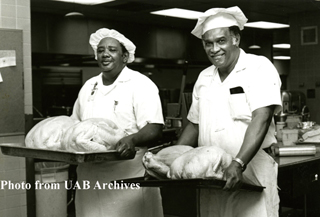
Preparing a feast for Thanksgiving Dinner, 1978
Hospital dietetics supervisors Ollie Griffie, Jr., (left) and Beverly Willingham (right) with some of the 700 pounds of turkey served in University Hospital on the holiday. The dietetics department also prepared over 300 pounds of sweet potatoes and 15 cases of cranberries.
Image ID: P7.4.1, #0993

Drs. Tinsley R. Harrison and Champ Lyons receive honorary degrees, October 1, 1965
In a special convocation ceremony at the Medical Center, the two medical school faculty members received honorary Doctor of Science degrees from The University of Alabama. The previous October, the two physicians had been named Distinguished Professors, the first such designations awarded in the history of the university system. Pictured at the Birmingham ceremony are (left to right): President Frank A. Rose, Harrison, Vice President Joseph F. Volker, and Lyons.
Image ID: P7.1.2, #0170

Nursing students receive instruction in University Hospital, 1967
Reviewing a patient’s chart are (left to right) Linda West, Instructor June Williamson, Sandra Moody, and Frances Pippen. The School of Nursing was founded in September 1950 and was originally located at The University of Alabama. Nursing students first traveled from the Tuscaloosa campus to the Birmingham medical center in June 1953 to obtain clinical training. In August 1967 the school was moved to Birmingham to become an integral component of UAB.
Image ID: P20.2, #1301

Registration for classes, 1971
A student considers her options during UAB’s campus registration held in the Bell Building gymnasium.
Image ID: P7.3.1, #1015

Quarterback Tower nears completion, July 1977
The Monday Morning Quarterback Club Tower was dedicated on July 18, 1977, adjacent to Jefferson Tower. This addition to University Hospital was made possible by funding from the Monday Morning Quarterback Club, a fundraising arm of the Crippled Children’s Foundation.
Image ID: P16.1.3, #3754

President S. Richardson Hill, Jr. and Gene Bartow, June 14, 1977
President S. Richardson Hill, Jr., welcomes Gene Bartow (right) to UAB as the university's first athletic director and head coach of a new men's intercollegiate basketball team, June 14, 1977. Dr. Hill recruited Coach Bartow to UAB from his position as head coach of basketball powerhouse UCLA. Bartow served as coach until 1996 and as athletic director until 2000. In 1997 the UAB Arena was renamed Bartow Arena in his honor.
Image ID: P7.2.7, #1180

Dr. Joseph F. Volker provides clinical instruction for dentists and dental students, Thailand, 1951
Volker (far right), the founding dean of the dental school at UAB, spent three months in Thailand as part of a US State Department education program. Volker's trip was the first of many for him and for other UAB faculty, a tradition that has continued for six decades. Today UAB is formally affiliated with several health science institutions in Thailand.
Image ID: P1, #0126
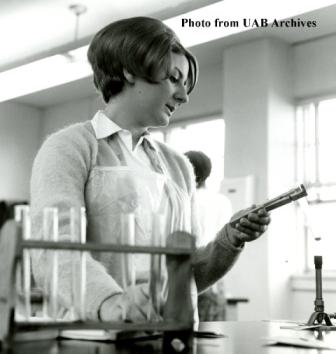
Student Julia Knight at work in the chemistry laboratory, 1967
The Department of Chemistry was established in 1966 as one of the original academic units in the College of General Studies. Originally housed within the Division of Natural Sciences and Mathematics, the chemistry department was part of the School of Natural Sciences and Mathematics from 1973 until 2009. In January 2010 chemistry became one of the academic departments in UAB's new College of Arts and Sciences.
Image ID: P7.2.7, #1935
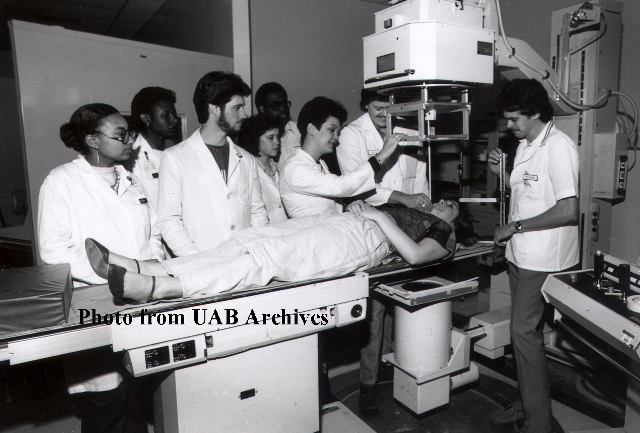
Students in the radiological technology program, circa 1975
The School of Health Professions has provided training in radiology technology since the school was originally established in 1969. But a certificate-level program had been offered within the hospital since 1944. When the School of Community and Allied Health Resources (today's School of Health Professions) was established, the program in radiology technology was transferred from the hospital to the new school.
Image ID: , P19.1, #0211

UAB's Olympian Vonetta Flowers in Bartow Arena, February 27, 2002
Earlier in the month at the Winter Olympics in Salt Lake City, Utah, Flowers and team-mate Jill Bakken won the inaugural Women's Bobsled event. Upon return to Birmingham, a public celebration was held in Bartow Arena for Flowers, an assistant coach of the UAB track team and an alumna of the university.
Image ID: P7.3.13, #1232
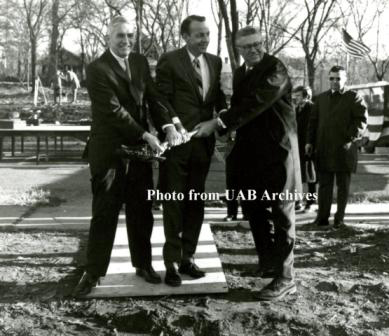
UAB expansion begins, January 30, 1970
At the groundbreaking ceremony for a new academic campus are (left to right): Dr. Joseph F. Volker, President of UAB; Albert P. Brewer, Governor of Alabama; and Dr. George W. Campbell, Dean of the College of General Studies. As faculty member Dr. Hubert Harper later remembered, they were in “a blighted environment…streets full of litter…some old houses still standing in the progressive decay… In this depressing environment…we stood in the dying day and the rising chill and witnessed" a very important occasion, the expansion of UAB. The first four buildings of this new western campus would be dedicated in ceremonies held in 1973.
Image ID: P7.2.1, #360

UAB Madrigal Feaste, December 1994
This dinner event is typically held during the Christmas season and is often accompanied by choral music and a play featuring characters from the Middle Ages.
Image ID: P23.1

A Midsummer Night's Dream, 1999
This play opened on November 10, 1999 as the first UAB Department of Theatre production to be held in the new Sirote Theatre. The work had been adapted by Karma Ibsen to be set in the Antebellum South.
Image ID: P7.3.13, #085
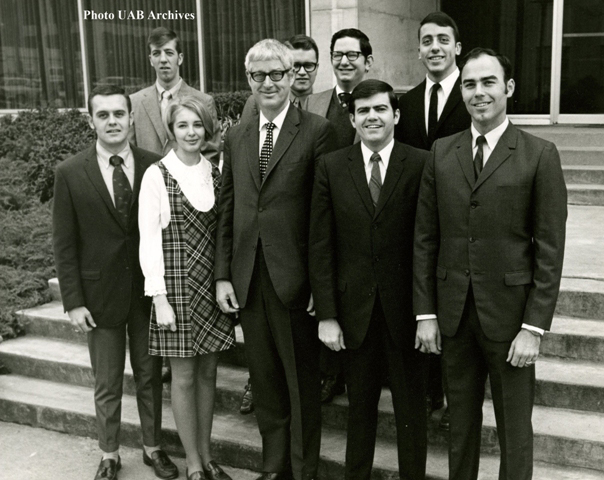
Dean Henry B. Peters and the first UAB optometry students, 1969
Members of the first class were recruited by Dean Peters and began their studies at the end of September 1969. Pictured are left to right: (front row) Michael E. Raim, Eugenie Sturtevant, Dean Henry B. Peters, Neil M. Bleakley, and Ronald E. Dachelet; and (back row) Nelson G. Crandall, Ernest S. Spohn, Alan G. Tavel, and Gene J. Terrezza. The School of Optometry awarded its first bachelor degrees in physiological optics in 1971 and its first Doctor of Optometry degrees in 1973.
Image ID: P21.2, #0517

UAB President Joseph F. Volker in his office, circa 1969
On June 16, 1969, Dr. Volker was named president-elect of the "University of Alabama in Birmingham," and he officially assumed the presidency of the newly independent university on September 5, 1969. The office of the new president was located on the first floor of the Lyons-Harrison Research Building; the same office he had occupied for years as vice president and head of all operations in Birmingham.
Image ID: P1, #0357
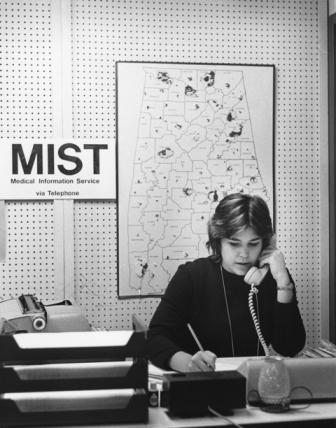
An attendant answers an incoming MIST call, circa 1975
Medical Information Service via Telephone (MIST), which began operation in August 1969, allowed Alabama physicians to call and discuss medical problems with specialists on duty at the UAB Medical Center. Later, the program expanded to physicians from across the country and it became a model for similar programs in other states.
Image ID: P7.2.7, #1010
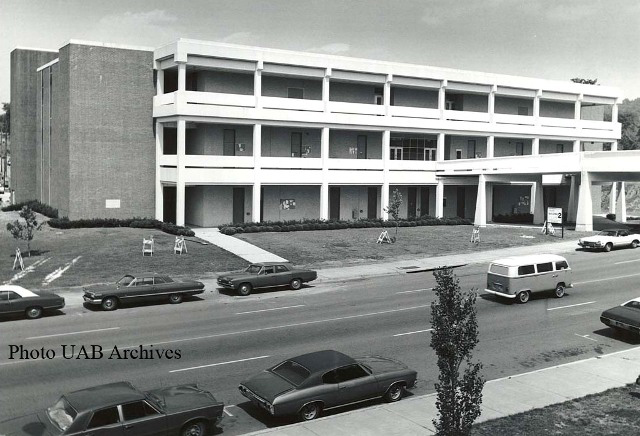
University College Building No. 2, circa 1978
Ground was broken in July 1970 for a new building in the developing campus of University College. This facility was completed and opened in June 1972 as the home to classrooms, laboratories, administrative offices, and several academic units. In 1983 the building was renamed the Physical Sciences Building. Following the completion of a renovation project, in 1995 the facility was renamed the Chemistry Building.
Image ID: P8.1.1, #0052
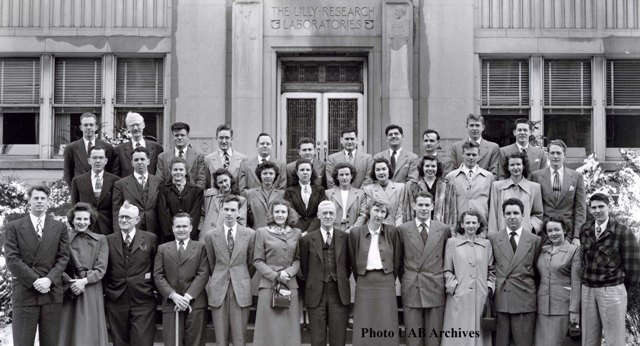
Class of 1949 tours the Eli Lilly Company, March 1949
On the trip to Indianapolis, Indiana, were thirty-five faculty, class members and spouses. On June 3, 1949, thirty-one students graduated from the Medical College of Alabama as the first class to complete all four years of medical education in Birmingham.
Image ID: MC51, #127l

